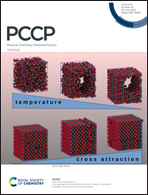The influence of Fermi level position at the GaN surface on carrier transfer across the MAPbI3/GaN interface†
Abstract
Both gallium nitride (GaN) and hybrid organic–inorganic perovskites such as methylammonium lead iodide (MAPbI3) have significantly influenced modern optoelectronics. Both marked a new beginning in the development of important branches in the semiconductor industry. For GaN, it is solid-state lighting and high-power electronics, and for MAPbI3, it is photovoltaics. Today, both are widely incorporated as building blocks in solar cells, LEDs and photodetectors. Regarding multilayers, and thus multi-interfacial construction of such devices, an understanding of the physical phenomena governing electronic transport at the interfaces is relevant. In this study, we present the spectroscopic investigation of carrier transfer across the MAPbI3/GaN interface by contactless electroreflectance (CER) for n-type and p-type GaN. The effect of MAPbI3 on the Fermi level position at the GaN surface was determined which allowed us to draw conclusions about the electronic phenomena at the interface. Our results show that MAPbI3 shifts the surface Fermi level deeper inside the GaN bandgap. Regarding different surface Fermi level positions for n-type and p-type GaN, we explain this as carrier transfer from GaN to MAPbI3 for n-type GaN and in the opposite direction for p-type GaN. We extend our outcomes with a demonstration of a broadband and self-powered MAPbI3/GaN photodetector.



 Please wait while we load your content...
Please wait while we load your content...